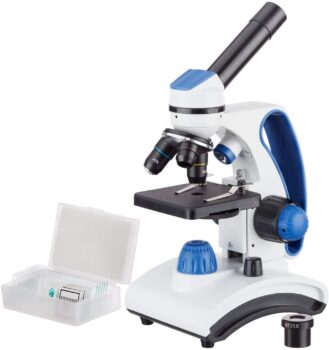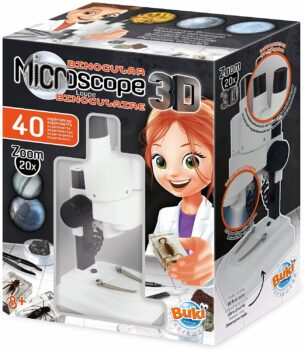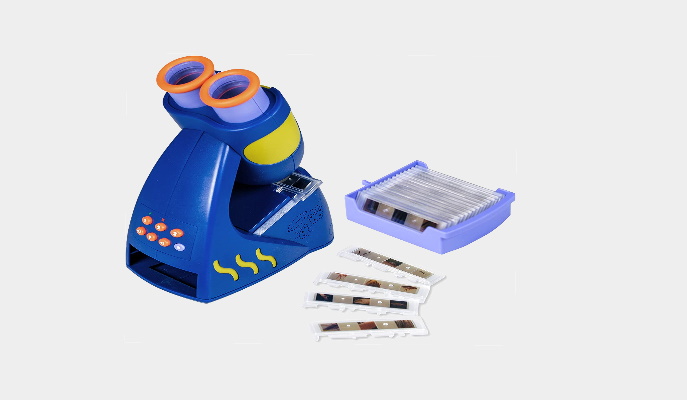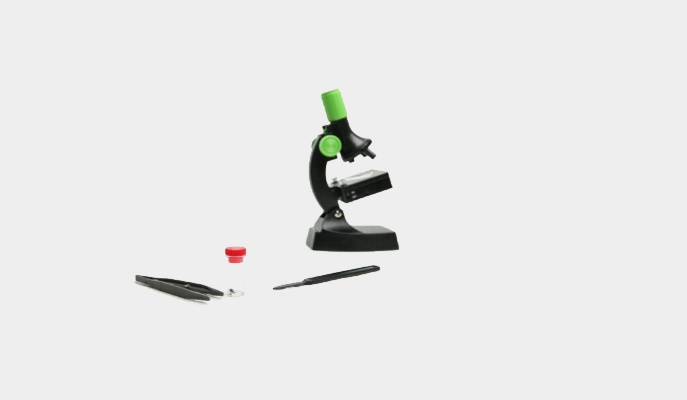Children are curious by nature, and the right microscope can be an incredible purchase for a child, opening up a fascinating new world and stimulating an interest in science. Are you looking for the best microscope for kids? Read our guide to find out more.
Here is our commitment, to make sure that we provide the best user experience and content quality:
You can support us by using our links to make your purchases (at no extra cost to you)! This sometimes earns us a commission which allows us to remain independent. More about us
Our selection
"Very playful, the microscope talks and children learn a lot of things while having fun and answering questions. This little microscope is ideal for small…"
"The Carson MM-300 Microbrite Plus LED pocket microscope is capable of 60-120x magnification. It has a particularly lightweight design, but is as effective as a…"
"This microscope is easy to handle and of good quality. Children will have no trouble using it thanks to its upper and lower LED lights…"
"Very precise microscope, it is of good quality, although a little fragile. You have to put it away after each use and remove the batteries…"

Very playful, the microscope talks and children learn a lot of things while having fun and answering questions. This little microscope is ideal for small children who get bored easily.
40,32 £ on AmazonIf you are looking for a first microscope to awaken your child's scientific curiosity, this one will do the trick. It will suit toddlers from 3 years old to 6 years old. It is a really interesting learning tool. It's easy to use and has two soft eyepieces so kids won't have to close one eye. This microscope offers 5x magnification and 20 prepared specimen holders with 60 images of animals, plants and familiar objects.
In addition to the two eyepieces, the microscope is also "animated" by the voice of nature advocate Bindi Irwin, so the child won't get bored. The 23 cm high microscope is powered by 3 AAA batteries (not included). This colorful and fun toy is a perfect first step in learning about insects, etc.

The Carson MM-300 Microbrite Plus LED pocket microscope is capable of 60-120x magnification. It has a particularly lightweight design, but is as effective as a more powerful device.
17,60 £ on AmazonHere you have a pocket microscope (9.91 x 6.6 x 3.81 cm) that fits perfectly in your pocket or backpack, so it is perfectly transportable (for school or just for adventure and discovery). This portable microscope has a built-in LED light that provides a bright and crystal clear image. The rubberized eyepiece makes viewing comfortable even for time-consuming tasks. It's ideal for both budding and accomplished scientists.
The Carson MicroBrite Plus uses a single AA battery. Two knobs allow you to focus and the other to gradually switch from 60X to 120X magnification. Entirely made of plastic, it weighs 68 g. This little device is easy to use and the grip is so simple. It is perfect for children from 10 years old.

This microscope is easy to handle and of good quality. Children will have no trouble using it thanks to its upper and lower LED lights and power supply.
79,99 £ on AmazonYou have here a microscope that has five magnifications, wide field, from 40X to 1000X, a single objective condenser and a 6-hole disc diaphragm, optical glass monoculars, a large field of view microscope, a double LED lighting for slides and opaque subjects. In addition, for added safety for the device and for your children, the microscope includes a metal construction with handle. The metal frame is sturdy and the focus is coaxial (coarse and fine).
And to allow your kids to get a good look at more opaque objects, such as pads, sand or bugs, the microscope has a top softness that provides mirror illumination. In short, the microscope is a complete set that comes with a 10-piece slide kit with five biological samples and five blank slides.

Very precise microscope, it is of good quality, although a little fragile. You have to put it away after each use and remove the batteries behind. It allows to study the samples in 3D, and has 40 experiments included explained step by step.
41,52 £ on AmazonAny specific needs?
The best children's microscope
The best entry-level children's microscope
Your guide :
Rate this buying guide :By rating this buying guide, you are helping us to reward our best writers. Thank you!
| TOP OF THE TOP | CHEAP | TOP OF THE LINE | EXCELLENT | |

In accordance with our commitment, this buying guide does not contain any sponsored products. |
 8/10 |
 7/10 |
 8/10 |
 8/10 |
| OUR SELECTION |
Learning Resources - Geo Safari Junior Talking
|
Carson - MicroBrite Plus
|
AmScope-Microscope child double light and glass lens
|
Buki - Microscope binoculaire
|
|
Very playful, the microscope talks and children learn a lot of things while having fun and answering questions. This little microscope is ideal for small children who get bored easily.
|
The Carson MM-300 Microbrite Plus LED pocket microscope is capable of 60-120x magnification. It has a particularly lightweight design, but is as effective as a more powerful device.
|
This microscope is easy to handle and of good quality. Children will have no trouble using it thanks to its upper and lower LED lights and power supply.
|
Very precise microscope, it is of good quality, although a little fragile. You have to put it away after each use and remove the batteries behind. It allows to study the samples in 3D, and has 40 experiments included explained step by step.
|
|
|
|
Talking learning tool
|
Pocket microscope
|
Microscope with five field magnifications from 40X to 1000X
|
Precise and very fun
|
|
|
Delivered with 20 prepared sample holders and 60 animal images
|
Practical and easy to use
|
Power supply+batteries included
|
3D microscope
|
|
|
Microscope with small tests for children
|
Magnification that goes from 60X to 120X
|
Microscope comes with a complete kit
|
40 experiments included and explained step by step
|
Help us improve this table:
Report an error, request the addition of a feature to the table, or suggest another product. Thank you for your kindness!
We spend thousands of hours each year studying the major specialized websites, analyzing products of hundreds of brands and reading user feedback to advise you on the best products.
We are a product review company with a single mission: to simplify your buying decisions. Our research and testing helps millions of people every year find the best products for their personal needs and budget.
To support us you can: use our links to make your purchases (which often earns us a small commission), share our articles on social networks, or recommend our site on your blog. Thanks in advance for your support!

For restless little humans, overly powerful optics could actually be counterproductive. As for your budding biologists, here's a rule of thumb: the younger the child, the lower the magnification. Magnifications between 5X and 400X are common recommendations for children under the age of 10. For older budding scientists, consider microscopes with more powerful optics.
Look for sturdy construction materials, such as aluminum alloy and durable plastics. If the microscope is intended for someone younger than 10, you'll probably want one that can take a little abuse. Some microscopes are specifically designed for little fingers, while others can be used for all ages.
For children under 5, look for more kid-friendly features, such as rounded edges, rubberized (shockproof) construction, and padded eyepieces.
Low-power (i.e., "stereo") microscopes are useful for viewing opaque objects (think rocks and coins); the light source is split into two separate paths to produce a 3D view. High-power (i.e., "compound") microscopes are for viewing translucent materials such as plant cells or viral bacteria; there is only one light source to produce a planar view.
All microscopes require a light source: the most common are LED, halogen, and fluorescent. Because of their brightness and longevity, LED lights are very popular in microscope equipment. If your microscope uses multiple bulbs, check to see if it comes with replacements; some bulbs are harder to replace than others.
Some microscopes contain only the basics, but the best microscopes for kids include useful accessories, such as activity books, specimen slides, carrying cases, specimen experiments, and complementary science tools.
Microscopes are devices that use lenses and illumination to magnify small things and to make target objects more clearly visible. In general, microscopes are made up of a number of different lenses that work in combination. With the illumination system, the way the illumination is applied and the type of illumination can be changed, depending on the nature of the object to be viewed, to make it clearer.
Ordinary microscopes consist mainly of two types of lenses, an objective lens and an eyepiece, as well as a stage for placing the target object and an illumination system. The object placed on the stage is first magnified by the nearby objective lens. It is then further magnified by the eyepiece, making the object appear larger.
Monocular microscopes work well up to 1000X, but for higher magnification levels, binocular microscopes are a necessary investment.

For something a little more advanced than a hand-held magnifier, the best microscope for this age group is a fixed stereo microscope, which has two eyepieces like a pair of binoculars! When objects are seen, they will appear clearly in three dimensions and have enough microscopic detail to interest a child while still allowing them to understand what they are seeing.
These types of microscopes require good external lighting, as the objects being viewed will not be transparent, this can easily be provided by a nearby lamp or perhaps built into the microscope.
An example of this type of microscope is the Learning Resources My First Microscope which is a great choice for young children as it is easy to focus with two large eyepieces, has 8x magnification, is bulky and sturdy, making it perfect for younger children. It has a built-in LED light to help children see objects. The microscope can be focused by turning the knob to lower or raise the eyepieces.

As children of this age are very curious and like to experiment, the microscope dedicated to them is the one that doesn't get damaged easily and children can take with them everywhere.
Like the Brainstorm Outdoor Adventure microscope, for example. This is a portable microscope perfect for outdoor exploration. With a single eyepiece, it's easy to use with a 20x to 40x zoom and an internal LED to illuminate the object. It is so easy to use that no focusing is required, just place the adventure microscope against what you want to look at!

Compound microscopes are more difficult to use, but give much more detail. They consist of an eyepiece and usually three lenses. Rotating the lenses changes the level of magnification. Objects should be more or less transparent and are viewed on slides illuminated from below.
Help may be needed to learn how to use this microscope to avoid frustration. It is recommended to always center the slides on the lowest magnification before gradually moving to higher magnifications. The effort is well worth it, because from a magnification of x400 and higher, you can see bacteria and amoebas swimming in the water! This particular microscope goes up to a magnification of x900!
There's no better way to spark your child's scientific curiosity than with a children's microscope. In fact, schools use microscopes and magnification on a range of subjects: from miniature magnifying glasses in elementary school to real microscopes in high school science classes. But there's nothing to stop you letting them have fun with it, even outside of school.
Girls and boys are natural scientists: they experiment and explore and test and repeat and (most importantly!) learn from experience. So setting up a little science lab for them can be a great idea to get them interested in science early on. A small lab equipped with sticky chemistry experiment kits, butterfly hatching kits, etc. There are many science toys for all ages, from toddler to school age.
Whether it is the children's laboratory or just the microscope, both alternatives bring awakening, satisfaction of scientific curiosity and an ability to analyze objects and elements that surround them. It is mainly in terms of investment and space management that things can differ.
If you have the space and the means, you can easily set up a small laboratory for your child. But if you lack space and can only invest in one toy, a child's microscope will be more than enough to arouse their curiosity.
Handle with care
Improper handling is a common cause of many problems that occur with microscopes. When carrying a microscope, hold it by the base and metal support arm.
Store in a safe place
Store your microscope in a clean, dry, well-ventilated area. Salty or humid air, for example, can damage the equipment over time. Expensive precision equipment should not be stored near solutions that could leak. Similarly, keep your microscope away from areas with potentially corrosive chemical fumes. Such fumes can destroy lenses or erode metal parts. And anyway, this kind of place will definitely not be suitable for children.
Take care of the lenses.
When your child uses his microscope, the objective lens is lowered to adjust the focus. However, show him or her that care must be taken not to let the objective lens touch the slide, as this could damage the lens. Also, dirty lenses are notoriously difficult to clean, so teach him to avoid getting them dirty as much as possible.
Take care of the bulbs
Teach your child to turn off the illuminator and wait for it to cool before putting it away. Letting the bulb cool will extend its life and avoid the unnecessary cost of expensive replacements. Also, if used constantly at full power, the bulb will overheat (and may even explode). Also, remember to turn off the illuminator when not in use.
Clean thoroughly
Microscope lenses are delicate. Teach your child to handle it carefully to avoid any scratches. You can use a vacuum cleaner to remove dust. Moisten a special lens paper with distilled water or an appropriate cleaning solution. Gently rubbing in circular motions will remove any sticky residue. Never use abrasives on microscope lenses.
The best children's microscope depends on your needs and budget. Read our buying guide to find out more.
When we hear the word "microscope" we all think of the classic idea of microscopes, bubbling test tubes and vials of strange chemicals like in the classic illustrated science game. However, these days there are many products that are more suitable for children! The first thing to consider is age: because children under five cannot easily concentrate with one eye. Also, the inversion of images (microscopes have two sets of lenses that turn the image the wrong way round!) at higher magnifications can confuse adults, let alone a child.
Digital microscopes for children are available in a variety of options. A basic digital microscope will simply replace the microscope eyepiece with a digital camera. This digital microscope allows the user to view a live image on the computer and capture and save images. A more advanced digital microscope would be a WiFi microscope that allows users to view live images on an app on their tablet or smartphone. And finally, an LCD digital microscope has an HD monitor mounted directly on the microscope so kids can gather around and everyone can see the live image at the same time. This type of microscope is expensive and requires a lot of investment. So make sure that it is really necessary so that you don't make unnecessary expenses.
Before you buy a children's microscope, think about where you're going to put the microscope. Is it near an outlet? If so, you probably don't need to worry about having a wireless option. However, if the area where you want your kids to work with their microscope doesn't have an outlet nearby, a wireless microscope will prevent kids from tripping or knocking the microscope off the table by pulling on the cord. As you read through our comprehensive guide, you'll notice in our comparison table some reliable and practical models.
A microscope is a scientific instrument and its use requires proper education and support. After all, improper handling can damage the instrument (e.g., crushing the objective into the slide). Sooner or later, the child will have observed all the slides and samples provided and will want to observe new things. Guidance is then needed to prepare more samples (unless you buy ready-made slides). Safety issues also need to be considered: how to protect the microscope and how to protect the child? Some of the chemicals used for sample preparation are toxic, so do not use them or trust them blindly. However, there are also many non-toxic alternatives and parents may need to do a little research. There is also the risk of cutting yourself when preparing the samples. You may also need to research the different types of specimens that can be observed - yes, a microscope does require guidance.
Every month we help more than 1 000 000 people buy better and smarter.
Copyright © 2022 - Made with ♥ by buyingbetter.co.uk
Your reviews and buying guides 0% advertising, 100% independent!